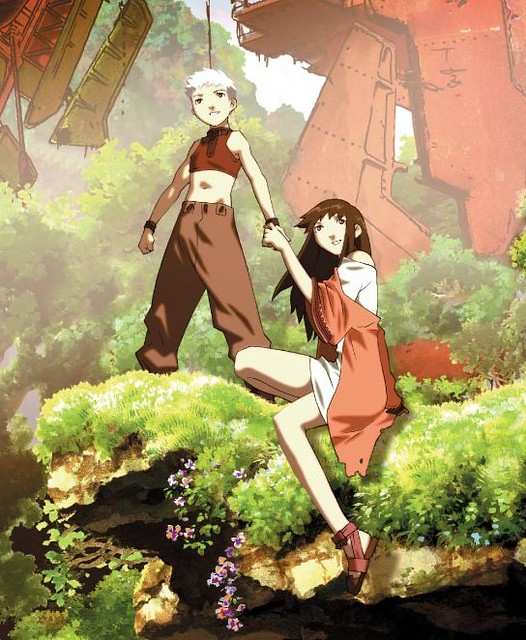From Beyond to the Apocalypse
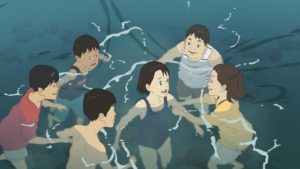 As we live in an information-saturated world, and it is difficult to absorb more than a tiny bit of it, it is usual people to make generalizations out of their personal tastes. So, a loto of people imagine that animations are products intended for children, and that Disney is the best in this area. Well, it’s impossible to deny the importance of Disney mainly because of its founder, and that, too, nowadays, the acquisition of Pixar has raised the studio to another level.
As we live in an information-saturated world, and it is difficult to absorb more than a tiny bit of it, it is usual people to make generalizations out of their personal tastes. So, a loto of people imagine that animations are products intended for children, and that Disney is the best in this area. Well, it’s impossible to deny the importance of Disney mainly because of its founder, and that, too, nowadays, the acquisition of Pixar has raised the studio to another level.
However, an equally important animation production hub is on the other side of the world, Japan. Fans will soon think of Studio Ghibli, responsible for such wonderful creations as “Spirited Away” (“Sen to Chihiro no kamikakushi”, JAP, 2001), winner of the 2003 Oscar for Best Animation. In fact, the country of the Rising Sun has a long tradition of very high quality animations – and not always aimed at children.
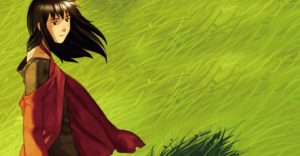 I remember that here in Brazil there was a great controversy about a car advertising that used an animation with an adult focus, exactly for this association between the cartoons and the children. In Japan there are animations for all audiences and tastes, ranging from very heavy dramas, such as Isao Takahata’s moving “Grave of the Fireflies” (“Hotaru no haka”,JPA,1988) to erotic stories, the so-called hentai.
I remember that here in Brazil there was a great controversy about a car advertising that used an animation with an adult focus, exactly for this association between the cartoons and the children. In Japan there are animations for all audiences and tastes, ranging from very heavy dramas, such as Isao Takahata’s moving “Grave of the Fireflies” (“Hotaru no haka”,JPA,1988) to erotic stories, the so-called hentai.
From this wonderfully prolific universe, I had the opportunity recently to watch two beautiful animations, with very different themes: “A Letter to Momo” (“Momo e no tegami”, JAP, 2011) and “Origin: Spirits of the Past” (“Gin-iro no kami no Agito”, JAP, 2006).
 “A Letter to Momo” unites a delicate story of loss with elements of Japanese folklore and culture, a recurring theme in their animations. Momo is a ten-year-old girl who, after her father’s unexpected death, is forced to relocate from vibrant Tokyo to the remote island of Shio, where the remnants of her mother’s family reside.
“A Letter to Momo” unites a delicate story of loss with elements of Japanese folklore and culture, a recurring theme in their animations. Momo is a ten-year-old girl who, after her father’s unexpected death, is forced to relocate from vibrant Tokyo to the remote island of Shio, where the remnants of her mother’s family reside.
In addition to losing the way of life she was used to, friends and school, Momo is also disturbed by a strange discovery, a letter that her father had begun to write to her, which contained only the words “dear Momo”. This is compounded by the fact that, before her father’s death, she had had a serious argument with him, which weighed heavily on her conscience.
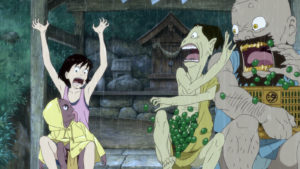 While her mother deals with her own difficulties, Momo tries to adapt to the island’s bucolic environment, which makes her terribly bored. It is then that arise in her life three strange supernatural beings, whose mission is to watch over the girl and her mother. The gigantic Iwa, the flatulent Kawa, and the childish Mame hinder more than they help, including the fact that they should be invisible, but Momo can interact with them all the time. While struggling with her own uncertainties and regrets, Momo has to control the troubled beings, including helping to save his mother’s life.
While her mother deals with her own difficulties, Momo tries to adapt to the island’s bucolic environment, which makes her terribly bored. It is then that arise in her life three strange supernatural beings, whose mission is to watch over the girl and her mother. The gigantic Iwa, the flatulent Kawa, and the childish Mame hinder more than they help, including the fact that they should be invisible, but Momo can interact with them all the time. While struggling with her own uncertainties and regrets, Momo has to control the troubled beings, including helping to save his mother’s life.
 “A Letter to Momo” is a beautiful fable of loss and overcoming, with an emphasis on good family values, friendship and determination. Although perfectly normal to Japanese culture, all supernatural beings are deformed and even monstrous, differing greatly from the coadjuvant cuddles of Western productions. In fact, another feature of Japanese animations is the absence of the dichotomy “this is of good, that is of evil.”
“A Letter to Momo” is a beautiful fable of loss and overcoming, with an emphasis on good family values, friendship and determination. Although perfectly normal to Japanese culture, all supernatural beings are deformed and even monstrous, differing greatly from the coadjuvant cuddles of Western productions. In fact, another feature of Japanese animations is the absence of the dichotomy “this is of good, that is of evil.”
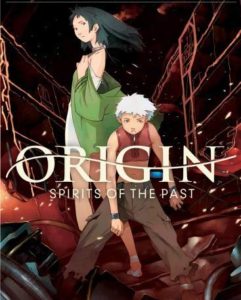 In “Origin: Spirits of the Past” we find another very common theme in Japanese anime, life in a post-apocalyptic environment. This fixation has a historical reason: Japan was the only nation to suffer a nuclear attack that affected an entire civilian population, with effects lasting for decades!
In “Origin: Spirits of the Past” we find another very common theme in Japanese anime, life in a post-apocalyptic environment. This fixation has a historical reason: Japan was the only nation to suffer a nuclear attack that affected an entire civilian population, with effects lasting for decades!
The plot of the film takes place about three hundred years into the future, after plants developed in labs on the moon destroyed Earth’s civilization and dominated the planet. The Forest, an intelligent and powerful entity, not only defeated humans, but also found a way to transform them into Intensified Humans.
 Some of these modified humans have managed to coexist with the Forest, creating a community called the Neutral City, while the more resilient ones have gone elsewhere, entrenching themselves in an industrialized stronghold, the city of Laguna.
Some of these modified humans have managed to coexist with the Forest, creating a community called the Neutral City, while the more resilient ones have gone elsewhere, entrenching themselves in an industrialized stronghold, the city of Laguna.
In Neutral City live Agito and Cain, two lively boys and always prone to commit some mischief that went against the strict code of behavior agreed with the Forest. One of these times, Agito enters the depths of the forest-dominated mountain, and discovers an ancient spaceship that brought humans from the moon.
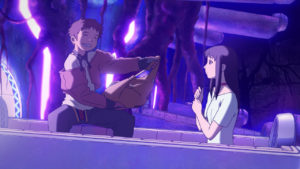 Amid the wreckage, Agito finds a capsule with a girl still in suspended animation. Its presence causes the capsule to awaken the girl, bringing her back to life. Agito discovers that the girl belonged to the ancient civilization, and was called Tula.
Amid the wreckage, Agito finds a capsule with a girl still in suspended animation. Its presence causes the capsule to awaken the girl, bringing her back to life. Agito discovers that the girl belonged to the ancient civilization, and was called Tula.
As Tula tries to adapt to the new world, her presence has already been noted by both the Forest and humans of Laguna, where there was also another survivor of the past. A young man named Shunack had also survived and was serving the city’s army, thanks to his knowledge of the Forest.
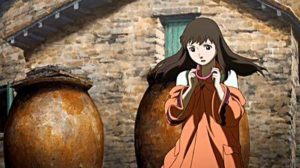 It doesn’t take long for a detachment of Laguna soldiers to come with Shunack in search of Tula. She was the daughter of Sakura, a scientist who had devised a solution for humans to break free of the Forest.
It doesn’t take long for a detachment of Laguna soldiers to come with Shunack in search of Tula. She was the daughter of Sakura, a scientist who had devised a solution for humans to break free of the Forest.
Shunack convinces Tula to accompany him to an old military installation designed by Dr Sakura, and activate his solution against the Forest. But Shunack has his own agenda, and when his evil goals are revealed, it turns out that Earth’s current situation is a consequence of his past actions. Now the hope is in Agito, with the support of all humans and vegetables.
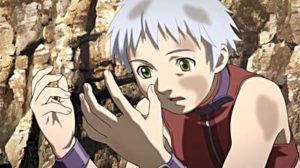 “Origin: Spirits of the Past” brings a curious story about man’s relationship with nature, and the dangers that can shake the delicate balance of the world we live in, with a growing and irresponsible attitude of people and governments destroying everything inconsequently .
“Origin: Spirits of the Past” brings a curious story about man’s relationship with nature, and the dangers that can shake the delicate balance of the world we live in, with a growing and irresponsible attitude of people and governments destroying everything inconsequently .
Unlike recent three-dimensional animations that have hit the market, Japanese productions still use traditional 2D drawing techniques, placing more emphasis on stories and expressions. For those who love the cartoon, whatever the technique used, it is always a pleasure to watch these wonderful stories.

